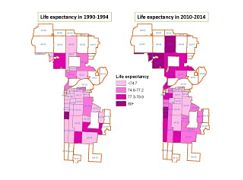Overview
After data revealed place-based inequities in life expectancy in Kansas City, Missouri, the local health department advocated for the inclusion of life expectancy as a strategic objective in the City’s business plan. They also convened a summit of city staff to examine how to address these inequities across departments.
Who Took This On
Kansas City, Missouri Health Department
Ways You Can Get Started
- Analyze inequities in life expectancy across neighborhoods
- Present the data to leaders of city departments, elected officials, and community organizations and start a conversation about what’s at stake
See Advice for Local Health Departments below for more ways to take action.
What Sparked This?
Disparities data spark Health Commission and Community Health Improvement Plan
In 2000, the new Kansas City, MO, Director of Health and department staff found that White residents of Kansas City lived on average 6.5 years longer than African American residents and that roughly half of the city’s annual deaths could be attributed to social factors such as segregation, poverty, violence, and a lack of education. These stunning findings led to the creation of the Mayor’s Kansas City Health Commission and the launch of the City’s first Community Health Improvement Plan (CHIP).
To support community engagement in the CHIP process, the Kansas City, MO, Health Department (KCMOHD) began working closely with organizers from Communities Creating Opportunity and other Kansas City community organizations. See the other Kansas City case study for details about the partnership and their impressive policy outcomes.
Community Health Improvement Plan focuses on social determinants of health
“Because we asked different questions, we ended up with a CHIP that is mostly in domains outside of the public health services.”
During its CHIP process, the Health Commission adopted new methods of gathering community input and broadened the scope of questions asked of residents. Unlike previous Kansas City CHIPs and CHIPs in other jurisdictions that typically focus on indicators of clinical care, the 2016–2021 KC-CHIP focused largely on the social determinants of health such as violence, education, economic opportunity, the built environment, and mental health and preventive care.
It was noted that KCMOHD and the Health Commission “own the creation of the CHIP, but we don’t own the CHIP — it is the entire city’s plan for how to improve community health. Once the City Council adopted the CHIP, it became clear that everyone else had to be involved in order to achieve these objectives.” It also became clear that KCMOHD needed restructuring and shoring up of their policy capabilities to advance the CHIP.
Community Engagement, Policy and Accountability division created
Although Kansas City made great strides in engaging the community and addressing the social determinants of health, and was awarded the 2015 Robert Wood Johnson Foundation Culture of Health Award, inequities in life expectancy continued. Believing that more focused cross-sector government action was needed, the KCMOHD Director and the Health Commission mobilized resources to create a new division that was responsible for incorporating health equity into the work of other city departments with special attention to local, state, and federal policy.
In 2016, the new Community Engagement, Policy and Accountability (CEPA) division was created. CEPA includes a division manager, 3 full-time statisticians, a policy analyst who supports the Health Commission, administrative support, and a city management fellow on rotation who serves as a project manager for many interdepartmental projects. The CEPA Manager notes that the team’s diverse and complementary skill sets in statistics, general policy analysis, and communications are key to the team’s success.
CEPA division develops relationships with City Manager and other city agencies
One of the CEPA team’s assigned duties was to oversee performance management for KCMOHD, which led to relationship building with the Office of Performance Management. At the same time, the new CEPA division staff were tasked with strengthening and advancing relationships with other city agencies.
Armed with data about inequities in life expectancy and social determinants of health, and with their City Council–approved Community Health Improvement Plan, CEPA staff began to more aggressively integrate health into conversations with leaders and key program staff across all of the city’s agencies. They also began building relationships with the Mayor and the City Manager, who over time became champions for KCMOHD’s work, urged city departments to work together more, and helped CEPA frame the work as being a model for government efficiency and delivery across departments, rather than as creating a need to hire more staff.
Inequities in life expectancy included in the City’s business plan
Building on the data and political commitment in the CHIP to address life expectancy inequities, KCMOHD staff advocated for the inclusion of life expectancy as a strategic objective in the City’s business plan. The Citywide Business Plan serves to align departmental strategic plans, the Financial Strategic Plan, and the Five-Year Planning Model, and serves as the driver for the Fiscal Year 2018 Submitted Budget.
As the city directors discussed the plan, the KCMOHD Director brought multiple staff to participate in different subgroups to raise health issues and discuss the idea of including life expectancy in the plan. Life expectancy was viewed as a good measure because it is cumulatively affected by the social determinants of health and access to health care services. Although there was some initial pushback, the Director emphasized that life expectancy was a needle that could be moved by KCMOHD with support from other city agencies over the course of 5 years. KCMOHD successfully advocated for its inclusion, and one of the stated departmental strategic objectives for 2017–2022 is to:
“Increase overall life expectancy and reduce health inequities in the zip codes with the lowest life expectancy: 64109, 64126, 64127, 64128, 64130, and 64132; and the additional zip codes with the least improvement in life expectancy: 64134, 64131, 64117, 64138, 64114, and 64133.”
This strategic objective helped pave the way for the development of the LifeX Summit to explore how the city could meet its stated goal.
Program Description
Recognizing that KCMOHD alone could not improve life expectancy across the city, communications staff suggested having a citywide summit on life expectancy. After receiving support from leadership for the idea, staff worked closely with the City Manager to host the LifeX Summit in November 2016. Close to 100 leaders attended representing all 20 city departments.
How did departments prepare for the LifeX Summit?
The primary objective of the LifeX Summit was to facilitate cross-sector work to increase life expectancy and decrease inequities in specific zip codes. Prior to the summit, the City Manager asked each department to prepare an overview of what programs, services, and other activities their department was currently doing and would like to do in the specific zip codes.
At the LifeX Summit, representatives of the health, neighborhoods, and city planning departments jointly presented historical trends in life expectancy (see PowerPoint presentation of historical trends). LifeX participants broke into small, facilitated breakout groups (see facilitation guide) where they discussed what their respective departments were currently doing that could impact life expectancy and what they would like to do moving forward. Following a productive networking lunch, all of the small groups reported back about their discussions and ideas. Following the LifeX Summit, KCMOHD compiled input they received and developed a cross walk with objectives of the Citywide Business Plan that was shared with the City Manager.
Outcomes and Impacts
-
Breaking out of silos:
As noted by summit organizers, “LifeX represents an opportunity to break out of historical silos and work across departments to improve life expectancy and decrease inequities between zip codes. The thematic takeaway from this day was that department leadership identified interdepartmental communication as a critical component of the LifeX approach. Communication should be meaningful and ongoing and result in tangible projects that make daily work more efficient without feeling burdensome.”
-
Bringing health to the table:
KCMOHD is now finding that it is invited to meetings with other departments and sometimes even asked to facilitate meetings. Other departments now see the value in having KCMOHD at the table, to bring health data, facilitation skills, and a social determinants of health lens that shows how diverse city functions collectively impact health. Because of LifeX, KCMOHD staff are meaningfully involved in the development of comprehensive bike and pedestrian plans; they participate on teams for digital equity, school attendance, housing, arts and culture, and transit connectivity; and they are serving as the conveners of a citywide economic mobility plan that is in its early stages.
-
Parks and Recreation Department takes action:
Moved by LifeX data, Parks and Recreation Department leadership adopted a new policy that anyone who lives in the 6 zip codes with the lowest life expectancy could get a free pass to community recreation centers, regardless of income, and could continue receiving a free pass if they participate in neighborhood meetings or do other forms of civic engagement. KCMOHD is working with the Parks and Recreation Department to evaluate the impact of this program on individual and community health.
Future Steps
Building on the success of the November 2016 LifeX Summit, CEPA wants to:
- Continue building on the relationships developed with other city agencies to further develop strong public health laws that target the social determinants of health
- Do more work internally with KCMOHD staff to explore where there are opportunities to advance health equity and promote social cohesion — for example, by leveraging relationships when staff participate in local community groups or civic associations
- Work with the tech sector to innovate around forecasting/predicting impacts of potential interventions — such as the Parks and Recreation Department free recreation passes, the economic mobility plan, or development incentives
Advice for Local Health Departments
-
Use language that works for local jurisdictions:
Although KCMOHD was fortunate to have progressive leaders within their department, Missouri is a very conservative state. From previous work, KCMOHD staff learned that there is an aversion across various city departments to checkboxes and the term Health in All Policies, so they had to be sensitive in how they advanced a Health in All Policies approach without explicitly using the term.
-
Focus on place:
Where one lives determines which services they receive — even rich people in zip codes with low life expectancy have worse outcomes than those in zip codes with high life expectancy. Focusing on place draws attention to the importance of social cohesion and connection to neighbors.
-
Look at life expectancy by zip code:
Neighborhoods are malleable and often have different names and boundaries depending upon the agency or real estate definition. Although census and block tract analyses are useful in certain contexts, zip codes resonate with bureaucrats, residents, and the general public, as well as funders.
-
Reference employees in analyses:
Almost half (43%) of city employees live in one of the 6 zip codes with the lowest life expectancy. That statistic has been a meaningful way to illustrate that many people affected by low life expectancy are closely connected to city government.
-
Create opportunities to sit and create together/office hours:
KCMOHD is not located in City Hall, and there are often missed opportunities for creative and casual conversations with other city staff. As a result, KCMOHD staff intentionally visit other agency staff in their offices, have created “health department office hours,” and are seeking out creative places outside of their offices to brainstorm and think through things together. Acknowledging the importance of space for collaboration, the City is in early planning phases of creating a public-sector innovation space.
-
Use Strengths Finder Tools when forming new teams/hiring new staff:
KCMOHD has used Strengths Assessment Tools across the department to help build a team with diverse and complementary skill sets and to help identify what each staff member’s strengths are.









